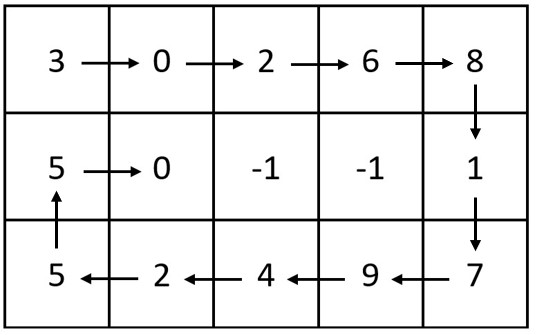- {x}
- Number of Distinct Roll Sequences
- Check if Matrix Is X-Matrix
- Count Number of Ways to Place Houses
- Maximum Score Of Spliced Array
- Minimum Score After Removals on a Tree
- Find Minimum Time to Finish All Jobs II
- Product Sales Analysis IV
- Decode the Message
- Spiral Matrix IV
- Number of People Aware of a Secret
- Number of Increasing Paths in a Grid
- Product Sales Analysis V
- Valid Palindrome IV
- Evaluate Boolean Binary Tree
- The Latest Time to Catch a Bus
- Minimum Sum of Squared Difference
- Subarray With Elements Greater Than Varying Threshold
- Read More...

Spiral Matrix IV
You are given two integers m and n, which represent the dimensions of a matrix.
You are also given the head of a linked list of integers.
Generate an m x n matrix that contains the integers in the linked list presented in spiral order (clockwise), starting from the top-left of the matrix. If there are remaining empty spaces, fill them with -1.
Return the generated matrix.
Example 1:

Input: m = 3, n = 5, head = [3,0,2,6,8,1,7,9,4,2,5,5,0] Output: [[3,0,2,6,8],[5,0,-1,-1,1],[5,2,4,9,7]] Explanation: The diagram above shows how the values are printed in the matrix. Note that the remaining spaces in the matrix are filled with -1.
Example 2:

Input: m = 1, n = 4, head = [0,1,2] Output: [[0,1,2,-1]] Explanation: The diagram above shows how the values are printed from left to right in the matrix. The last space in the matrix is set to -1.
Constraints:
1 <= m, n <= 1051 <= m * n <= 105- The number of nodes in the list is in the range
[1, m * n]. 0 <= Node.val <= 1000
Solution Explanation for Spiral Matrix IV
This problem involves creating an m x n matrix populated with values from a linked list in a spiral pattern (clockwise), filling remaining spaces with -1.
Approach: Simulation
The most straightforward approach is to simulate the spiral traversal. We use a matrix initialized with -1s and iterate through the linked list, placing each node's value into the matrix according to the spiral order.
Algorithm:
-
Initialization:
- Create an
m x nmatrixansfilled with -1. - Initialize
i,j(row and column indices) to 0. - Initialize
k(direction) to 0 (representing right). We'll use adirsarray to manage direction changes:dirs = [0, 1, 0, -1, 0]representing right, down, left, up.
- Create an
-
Spiral Traversal:
- While the linked list
headis not null (we still have values):- Place
head.valintoans[i][j]. - Move
headtohead.next. - Find Next Position:
- Use a
whileloop to find the next valid position:- Calculate the next position
(x, y)usingi + dirs[k]andj + dirs[k+1]. - If
(x, y)is within the matrix bounds (0 <= x < mand0 <= y < n) andans[x][y]is -1 (unoccupied), updateiandjtoxandyrespectively, and break the inner loop. - Otherwise, change direction by updating
k = (k + 1) % 4.
- Calculate the next position
- Use a
- Place
- While the linked list
-
Return: Return the
ansmatrix.
Time and Space Complexity
- Time Complexity: O(m * n) - In the worst case, we visit each cell of the matrix once. The linked list traversal is also linear in the number of nodes (which is at most m * n).
- Space Complexity: O(m * n) - The matrix
ansdominates the space complexity.
Code Implementation (Python)
# Definition for singly-linked list.
# class ListNode:
# def __init__(self, val=0, next=None):
# self.val = val
# self.next = next
class Solution:
def spiralMatrix(self, m: int, n: int, head: Optional[ListNode]) -> List[List[int]]:
ans = [[-1] * n for _ in range(m)]
i = j = k = 0
dirs = [0, 1, 0, -1, 0] # Right, Down, Left, Up
while head:
ans[i][j] = head.val
head = head.next
while True:
x, y = i + dirs[k], j + dirs[k + 1]
if 0 <= x < m and 0 <= y < n and ans[x][y] == -1:
i, j = x, y
break
k = (k + 1) % 4
return ansThe implementations in Java, C++, Go, and TypeScript follow the same logic, differing only in syntax. The core algorithm remains consistent across all languages.